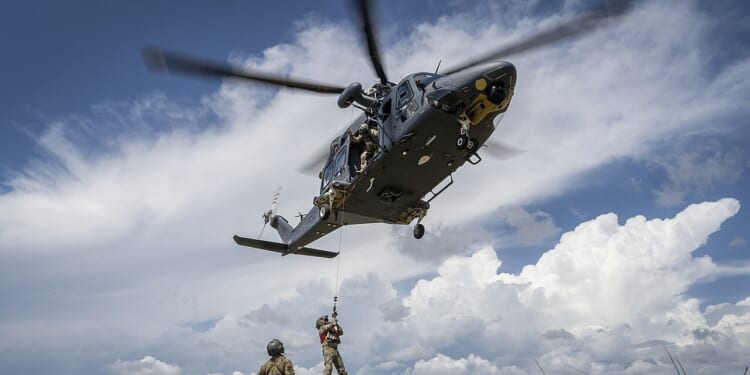With the MH-139A Grey Wolf, the Air Force is getting a more credible, agile, and survivable helicopter for missions tied directly to the nuclear deterrent.
The United States Air Force has awarded Boeing a contract worth around $173 million to build eight MH-139A “Grey Wolf” helicopters, along with training and sustainment support. That brings the total number of Grey Wolf helos under contract up to 34 aircraft. These birds are militarized versions of Leonardo’s AW139, customized by Boeing, for US Air Force missions. The Grey Wolf helicopters are being press-ganged into service because the Air Force’s UH-1N “Huey” helicopters are in dire need of replacement.
The UH-1N and, now the MH-139A helicopters will be used in nuclear missile security missions, such as patrolling and guarding intercontinental ballistic missile, ICBM, fields, escorting convoys, and rapid response.
The MH-139A Grey Wolf Helicopter’s Specifications
- Year Introduced: 2020
- Number Built: Unknown; 84 planned
- Length: 54.7 ft (16.67 m)
- Rotor Diameter: 45.2 ft (13.78 m)
- Weight: 14,110 lb (6,400 kg) MTOW
- Engines: Two Pratt & Whitney PT6C-67C turboshaft; 1,100 shp
- Top Speed: 135 knots (155 mph, 250 km/h)
- Range: 225 nmi (259 mi, 416.7 km)
- Service Ceiling: 20,000 ft (6,100 m)
- Loadout: Two M240 7.62mm machine guns
- Aircrew: 2 (pilot, flight engineer)
The MH-139A Grey Wolf helicopters are superior to their UH-1N Huey predecessors in nearly every respect. They have more speed, better range, and higher payload capacity than the Hueys. They also have superior avionics suites, secure communications, improved navigation and sensors, countermeasures, and a more heavily armored cockpit and cabin. The new birds can loiter longer, scramble faster over vast missile fields, and handle cold and high-altitude conditions better. In short, the Air Force is getting a more credible, agile, and survivable helicopter for missions tied directly to the nuclear deterrent.
Still, the Grey Wolf program has been a bumpy ride thus far. At one point, the Air Force cut plan purchases from around 74 birds to around 42 due to budgetary constraints. This, in turn, exploded the helicopter’s cost per unit—triggering a “Nunn-McCurdy breach,” a mandatory Congressional oversight hearing at which the Pentagon was required to justify spending dramatically more money on a system than it was budgeted for.
By ordering eight more choppers, the Air Force is telling Boeing that it remains committed to the program, despite its earlier concerns.
Some observers might be confused why the Grey Wolf is so important, given that it will primarily be used to patrol US nuclear missile facilities. But that’s precisely why the MH-139A is so important. America’s nuclear weapons arsenal has never been under the kind of threat that it is under now. During the Cold War, the Soviets targeted their nuclear weapons at US nuclear weapons silos. But that was only in the event of a full-blown nuclear world war. Today, with drones and other unconventional weapons, an enemy could theoretically attack US nuclear missile silos in ways that are extremely hard to detect or counteract. By having versatile helicopters at the ready, such as the MH-139A Grey Wolf, the Air Force can more effectively guard its physical nuclear weapons infrastructure.
Due to those aforementioned delays with this particular bird, and the fact that the United States desperately needs a reliable nuclear weapons silo security capability, many of the aging Hueys currently tasked with defense of America’s nuclear weapons facilities might need to have their lifespans stretched even more than they already have. This will then lead to complications in the Air Force’s overall sustainment of the aircraft involved with their nuclear missile defense mission.
Can the Air Force Rely on Foreign Supply Chains?
As for the role that Leonardo, the Grey Wolf’s Italian manufacturer, plays in the program, the fact that it is a foreign entity—even though it is partnered with Boeing—means that the supply chain supporting this new helicopter for the Air Force could be disrupted in ways that a domestic producer might not be impacted.
This $137 million deal for eight Grey Wolf helicopters is more than just a helicopter purchase. It amounts to a signal that the Pentagon is serious about prioritizing its nuclear weapons architecture, modernizing legacy systems, and keeping the industrial base alive.
Yet budgets are painfully tight, risks are great, and the program’s long-term success depends on keeping the momentum going and avoiding the trap of too-small buys driving up costs.
If everything goes well, these Grey Wolf helicopters multiply the strength and durability of America’s deterrent posture. If missteps occur, this could turn into another overbudget, underdelivered program that gets cut or hollowed out.
About the Author: Brandon J. Weichert
Brandon J. Weichert is a senior national security editor at The National Interest. Recently, Weichert became the host of The National Security Hour on America Outloud News and iHeartRadio, where he discusses national security policy every Wednesday at 8pm Eastern. He is also a contributor at Popular Mechanics and has consulted regularly with various government institutions and private organizations on geopolitical issues. Weichert’s writings have appeared in multiple publications, including The Washington Times, National Review, The American Spectator, MSN, The Asia Times, and countless others. His books include Winning Space: How America Remains a Superpower, Biohacked: China’s Race to Control Life, and The Shadow War: Iran’s Quest for Supremacy. His newest book, A Disaster of Our Own Making: How the West Lost Ukraine is available for purchase wherever books are sold. He can be followed via Twitter @WeTheBrandon.
Image: Wikimedia Commons.

















